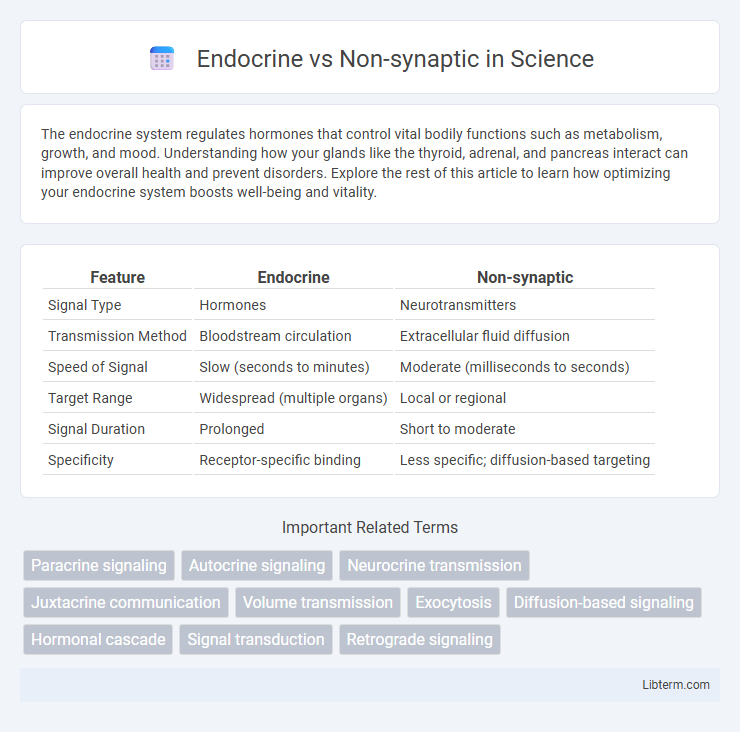The endocrine system regulates hormones that control vital bodily functions such as metabolism, growth, and mood. Understanding how your glands like the thyroid, adrenal, and pancreas interact can improve overall health and prevent disorders. Explore the rest of this article to learn how optimizing your endocrine system boosts well-being and vitality.
Table of Comparison
| Feature | Endocrine | Non-synaptic |
|---|---|---|
| Signal Type | Hormones | Neurotransmitters |
| Transmission Method | Bloodstream circulation | Extracellular fluid diffusion |
| Speed of Signal | Slow (seconds to minutes) | Moderate (milliseconds to seconds) |
| Target Range | Widespread (multiple organs) | Local or regional |
| Signal Duration | Prolonged | Short to moderate |
| Specificity | Receptor-specific binding | Less specific; diffusion-based targeting |
Introduction to Endocrine and Non-synaptic Communication
Endocrine communication involves the secretion of hormones by endocrine glands directly into the bloodstream, allowing signals to reach distant target cells and regulate physiological processes over time. Non-synaptic communication, including paracrine and autocrine signaling, relies on local chemical messengers diffusing through the extracellular fluid to influence nearby cells rapidly without direct synaptic contact. Understanding these distinct mechanisms highlights how cellular interactions vary in range, speed, and specificity to maintain homeostasis and coordinate complex biological functions.
Defining Endocrine Signaling Mechanisms
Endocrine signaling mechanisms involve the release of hormones from endocrine glands directly into the bloodstream, allowing them to travel long distances to target cells with specific receptors. These hormones regulate various physiological processes by binding to receptors on or inside target cells, triggering a cascade of intracellular events. In contrast, non-synaptic signaling, such as paracrine or autocrine communication, relies on the diffusion of signaling molecules to nearby cells without entering the bloodstream, enabling localized cellular responses.
Key Features of Non-synaptic Signaling
Non-synaptic signaling involves the release of chemical messengers that diffuse over a larger distance to affect target cells without direct synaptic contact, enabling more widespread and prolonged physiological effects compared to endocrine signaling. Key features include volume transmission, where signaling molecules travel through extracellular fluid, and paracrine mechanisms impacting nearby cells. This mode of communication is critical in modulating neural circuits and maintaining homeostasis beyond the confines of traditional synaptic junctions.
Molecular Pathways in Endocrine Regulation
Endocrine regulation primarily involves hormone secretion into the bloodstream, where molecular pathways such as the cAMP-PKA and MAPK cascades modulate gene expression and cellular responses systemically. In contrast, non-synaptic communication relies on paracrine or autocrine signaling mechanisms with localized receptor activation, often involving calcium-dependent pathways for rapid, short-range cellular effects. Understanding these molecular distinctions is crucial for developing targeted therapies in hormonal disorders and neuroendocrine diseases.
Modes of Non-synaptic Transmission
Non-synaptic transmission includes volume transmission, where neurotransmitters diffuse through extracellular fluid affecting multiple neurons, and ephaptic transmission, which involves electrical coupling between adjacent neurons via local electric fields without synaptic contacts. Endocrine signaling differs by releasing hormones into the bloodstream, enabling long-range communication to target distant organs, whereas non-synaptic modes operate locally and rapidly without the use of blood circulation. These non-synaptic mechanisms facilitate modulatory and integrative functions in neural networks beyond classical synaptic junction constraints.
Speed and Range: Endocrine vs Non-synaptic Responses
Endocrine responses involve the slow release of hormones into the bloodstream, resulting in widespread effects over extended periods, often minutes to hours, affecting distant target cells throughout the body. Non-synaptic signaling, such as volume transmission, operates more rapidly than endocrine methods, enabling faster and often localized communication without the need for direct cell contact. While endocrine responses cover a broad range with prolonged action, non-synaptic responses provide quicker signaling with varying spatial reach, typically influencing nearby cells within tissue.
Functional Roles in Physiology and Behavior
Endocrine signaling regulates long-term physiological processes like growth, metabolism, and reproduction by releasing hormones into the bloodstream to affect distant target organs. Non-synaptic communication, including volume transmission and paracrine signaling, modulates local neuronal and glial activity, influencing rapid behavioral responses and neural plasticity. These mechanisms complement each other, with endocrine pathways supporting systemic homeostasis while non-synaptic signaling fine-tunes neural circuit dynamics for adaptive behavior.
Examples of Endocrine Signaling in the Human Body
Endocrine signaling in the human body involves hormones like insulin, produced by the pancreas, regulating blood glucose levels, and thyroid hormones controlling metabolism and growth. Cortisol from the adrenal glands plays a critical role in stress response and immune modulation. These hormones travel through the bloodstream to distant target organs, contrasting with non-synaptic communication that relies on direct cellular contact or localized chemical signaling.
Non-synaptic Interactions in Nervous Systems
Non-synaptic interactions in nervous systems involve the diffusion of neurotransmitters or neuromodulators beyond synaptic clefts, affecting multiple neurons or glial cells in a localized area. These volume transmission mechanisms contrast with the highly specific signaling at synapses, enabling widespread modulation of neural circuits and influencing processes such as arousal, mood, and neuroplasticity. Key molecules in non-synaptic communication include monoamines like serotonin and dopamine, which regulate brain functions through extrasynaptic receptor activation.
Clinical Relevance: Disorders Involving Endocrine and Non-synaptic Pathways
Disorders involving endocrine pathways, such as hypothyroidism and Cushing's syndrome, result from hormonal imbalances disrupting metabolism, growth, or stress response. Non-synaptic signaling abnormalities are implicated in neurological conditions like epilepsy and neurodegenerative diseases, where altered neurotransmitter diffusion affects neural circuit function. Understanding these distinct mechanisms is crucial for developing targeted therapies to manage hormone-related disorders and synaptic transmission dysfunctions.
Endocrine Infographic

 libterm.com
libterm.com